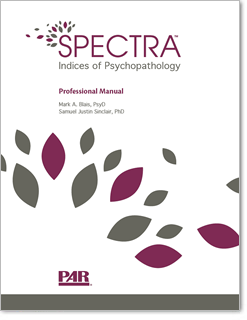
The SPECTRA provides a quick hierarchical assessment of adult psychopathology. It can be used to evaluate individuals in a variety of clinical settings, such as inpatient and outpatient clinics, hospitals, schools, and forensic settings.
Features and benefits
- Measures 12 clinically important constructs (depression, anxiety, social anxiety, post-traumatic stress, alcohol problems, severe aggression, antisocial behavior, drug problems, psychosis, paranoid ideation, manic activation, and grandiose ideation).
- Constructs are organized into three higher-order psychopathology spectra (Internalizing, Externalizing, and Reality-Impairing).
- These spectra scores combine to provide a General Psychopathology Index (GPI).
- Maps on to DSM-5™ conditions and links assessment findings to quantitative model research literature.
Test structure
Features 96 self-report items that can be completed and scored via carbonless form, plus three supplemental scales, one validity scale, and one response style indicator.
Technical information
- Normative data are based on a sample of 1,062 individuals ranging in age from 18 to 91 years representative of the U.S. population.
- Older adult, college student, and mild and moderate clinical samples were collected.
- SPECTRA scales correlate highly with the PID-5, PDQ, SBQ-R, PAI, NEO-FFI-3, BRIEF-A, and more.
- SPECTRA Fact Sheet with Scale information available here.
Test Abbreviation:
SPECTRA
Registration Level:
C
Age:
18+
Country of origin:
USA
Publisher:
Psychological Assessment Resources (PAR)
Copyright:
Mark A. Blais, PsyD, and Samuel Justin Sinclair, PhD 2018
Administration:
Paper
Timing:
15-20 minutes
Work Area:




